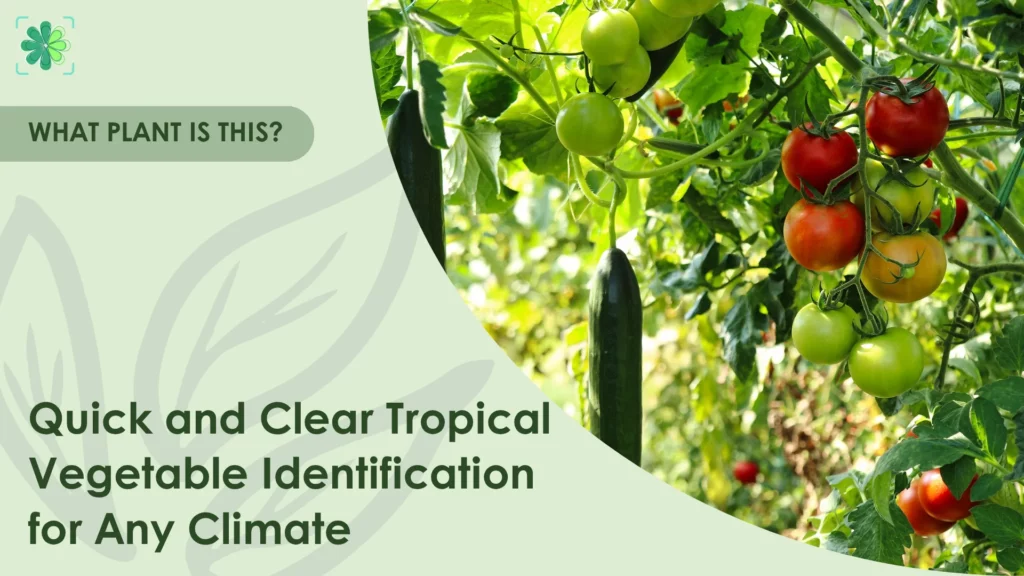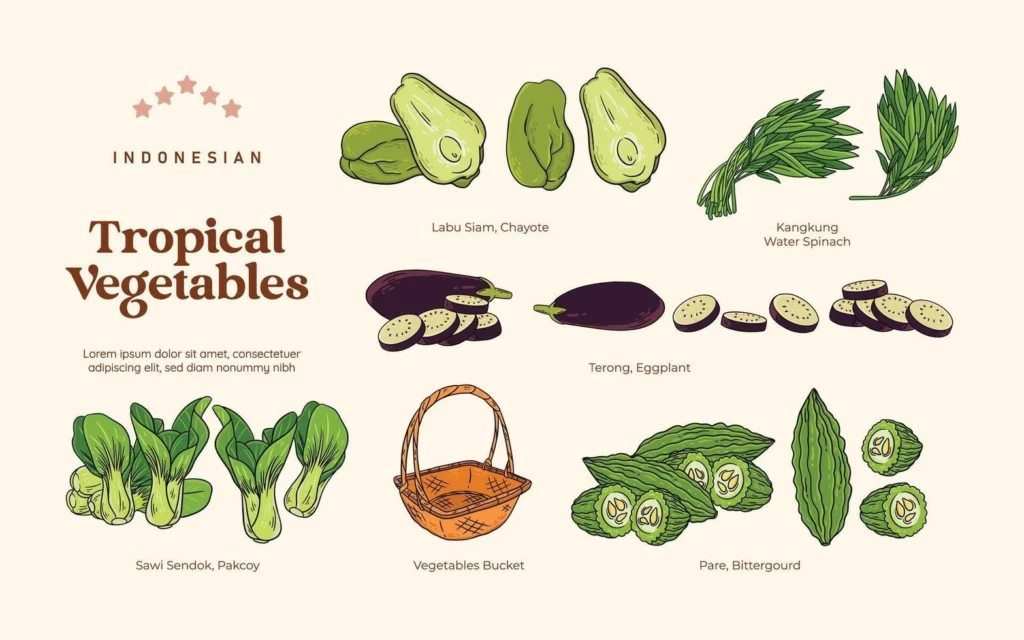
If you’re working with tropical crops, knowing what you’re growing is half the battle. This tropical vegetable identification guide shows how to recognize plants by their leaves, roots, flowers, and growth habits. You’ll also learn naming differences, plant families, and innovative tools to help you ID with confidence.
What Are Tropical Vegetables?
Tropical vegetables are edible plants that thrive in warm, humid climates with little or no frost. They grow year-round or in distinct wet and dry seasons, depending on the region. These crops tend to be heat-tolerant, fast-growing, and often resilient in low-input conditions, making them valuable in both backyard gardens and large-scale farms.
Vegetables are considered “tropical” when they meet the following criteria:
- Native to or widely cultivated in tropical or subtropical zones
- Suited to temperatures typically above 18°C (64°F)
- Often adapted to seasonal rainfall patterns rather than cold dormancy
- Show vigorous growth habits like climbing vines, sprawling shrubs, or deep taproots
Key growing regions for tropical vegetables include:
- Southeast Asia – Known for kangkong, bitter gourd, and taro
- Sub-Saharan Africa – Home to amaranth greens, okra, and African eggplant
- Parts of Latin America – Rich in chayote, cassava, and malanga varieties

Tropical vegetable identification helps us choose the right crops for warm climates, avoid cooking mix-ups, and support farmers who rely on accurate plant knowledge. It also protects biodiversity by recognizing local varieties. With many lookalike vegetables, getting it right matters more than ever.
How Tropical Vegetables Are Classified?
| Classification Method | Details | Examples |
| 1. By Plant Part | Grouped by the edible part of the plant | – Leafy: amaranth, kangkong, basella – Root/Tuber: taro, malanga, cassava – Fruit-bearing: okra, eggplant, bitter gourd – Legumes: long beans, winged beans |
| 2. By Plant Family | Based on botanical grouping, helpful in understanding plant traits | – Solanaceae: eggplant, chili – Cucurbitaceae: bitter gourd, chayote – Amaranthaceae: amaranth, celosia – Araceae: taro Fabaceae: winged bean |
| 3. By Naming System | Scientific names are consistent across regions; common names vary widely | – Solanum melongena = eggplant – Ipomoea aquatica = water spinach |
| 4. By Cultural or Regional Names | A single vegetable may have many local names | – Kangkong = water spinach – Bitter gourd = ampalaya = karela |
Visual Identification: Key Traits to Look For
For effective tropical vegetable identification, it helps to group traits into two major categories: above-ground adaptations and underground storage features. These adaptations reflect how tropical crops have evolved to withstand heat, heavy rainfall, and rapid seasonal growth cycles.
Above-Ground Adaptations
Tropical vegetables often thrive in intense sunlight and humidity, which shape the growth of their leaves and stems. These plants are fast-growing, flexible, and optimized for short, productive cycles.
Key traits:
- Leaves: broad, soft, and fast-growing to absorb sunlight quickly
- Colors: vibrant green, deep red, or purple (often heat-tolerant)
- Venation: visible midribs and veins for water transport
- Stems: often vining, creeping, or bushy for fast expansion
- Growth: quick to regrow after cutting, with little dormancy
These traits help distinguish tropical vegetables from temperate ones, which are often slower-growing and adapted to cold or dry periods.

Examples of tropical vegetables with strong above-ground traits:
| Leafy & Fruiting Types | Vining or Bushy Types |
| Amaranth | Kangkong (water spinach) |
| Basella (Malabar spinach) | Bitter gourd |
| Chaya (tree spinach) | Okra |
| African nightshade | Yardlong bean |
| Celosia (soko) | Climbing eggplant |
| Pumpkin leaves | Snake gourd |
| Moringa leaves (drumstick tree) | Chayote vines |
| Tete (Solanum macrocarpon leaves) | Winged bean |
| Sweet potato leaves | Bottle gourd |
| Mustard greens | Roselle (hibiscus leaves) |
Underground Storage
Many tropical vegetables develop storage organs underground to survive alternating wet and dry seasons. These include tuberous roots, corms, and rhizomes—each with distinct clues.
Key traits:
- Shape: swollen, elongated, or rounded storage parts
- Skin: fibrous or bark-like, often with protective outer layers
- Color: flesh may be white, yellow, purple, or creamy
- Other clues: visible root hairs, crowns, or eye buds
- Preparation needs: some require soaking or boiling to remove toxins
These structures are survival adaptations that signal the vegetable originated from a tropical or subtropical environment.

Examples of tropical vegetables with underground storage traits:
| Root/Tuber Crops | Corms & Rhizomes |
| Cassava (yuca) | Taro |
| Sweet potato | Malanga (yautía) |
| Yams (Dioscorea spp.) | Elephant foot yam |
| Jicama | Turmeric |
| Oca (Oxalis tuberosa) | Galangal |
| Ulluco | Lesser yam (Dioscorea esculenta) |
| Chinese water chestnut | Lotus root |
| Arrowroot | Zedoary (white turmeric) |
| Canna lily (achira) | Banana corm (non-fruiting type) |
| Tannia (Xanthosoma sagittifolium) | Ginger |
Advanced Botanical Classification for Tropical Vegetable Identification
For learners interested in scientific classification, advanced-level tropical vegetable identification involves understanding taxonomy, genetics, and plant physiology.
Key botanical families commonly seen in tropical vegetables include:
- Solanaceae – Eggplant, African nightshade, tomato
- Cucurbitaceae – Bitter gourd, bottle gourd, chayote
- Amaranthaceae – Amaranth, spinach, quinoa (though quinoa is temperate)
- Fabaceae – Yardlong bean, winged bean, pigeon pea
- Araceae – Taro, malanga, elephant foot yam
These families are grouped based on floral structure, leaf arrangement, and reproductive organs.
Chromosome counts and genus/species classification also play a role in understanding relatedness. For example:
- Solanum melongena (eggplant) has 24 chromosomes
- Ipomoea batatas (sweet potato) is hexaploid (90 chromosomes)
- Wild relatives often have different ploidy levels, which affects breeding compatibility
Why does this matter for tropical vegetable identification?
Understanding the genus and species helps distinguish between lookalike crops that may differ in edibility, toxicity, or growth habit. It also supports crop breeding and conservation. For instance, identifying whether a tuber belongs to Dioscorea or Xanthosoma can guide cultivation methods and nutritional expectations.
Conclusion
In the end, mastering tropical vegetables identification means fewer mix-ups, better crops, and more confidence in the field or kitchen. It doesn’t have to be complicated. Use the Planteyes app to recognize plants instantly and get expert-level support anytime.
FAQs
Can two tropical vegetables look the same but belong to different plant families?
Yes. For example, sweet potato (Convolvulaceae) and yam (Dioscoreaceae) both have starchy, tuberous roots but come from entirely different families. This is why tropical vegetable identification often relies on factors such as flower structure, stem growth, or leaf arrangement, rather than just root appearance.
Why do some tropical vegetables change appearance depending on where they grow?
Environmental factors, such as soil, rainfall, and sunlight, can influence plant size, leaf color, and fruit shape. For instance, eggplants grown in high humidity may have softer skin or paler color compared to those in drier areas. Microclimates play a major role in plant expression.
Is it possible to identify a tropical vegetable just by looking at the leaf veins?
Sometimes, yes, but it’s not always enough. Leaf venation (parallel, netted, or pinnate) can narrow down plant families (e.g., Amaranthaceae vs. Solanaceae). Still, for a confident ID, it should be combined with stem type, flower, and growth pattern.
What’s the trick to telling edible tropical vines from invasive or toxic ones?
Look at the leaf shape, tendril structure, and whether the vine produces edible fruit or sap. Edible vines like kangkong or basella have soft stems and are commonly cultivated. In contrast, wild vines with milky sap, acrid smell, or unfamiliar fruits should be avoided unless verified.
Can I ask questions directly in the app, like chatting with an expert?
Absolutely. Planteyes features a built-in chat function that allows you to converse with the app, much like messaging an AI expert. Ask about identification, care tips, or even recipe suggestions for the vegetable you’ve found.


